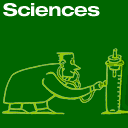Lizzie Burns
describes herself as a scientist, but is more likely to be seen wielding a
paintbrush than a test tube. Two years ago, while she was working as a
postdoctoral researcher in the biochemistry department at the University
of Oxford, she won a grant from the Medical Research Council to produce a
series of paintings and photographs of the different biomedical research
that it funds, with the rather daunting overall mission of engaging the
public in science.
Burns had been experimenting with ways of drawing scientific subjects
for some time, and had already done some illustrations for academic
journals. "I found it a great way to explain research to my friends," she
explains. "So I came up with a scientific-sounding proposal and approached
the MRC. It was open-minded of them, letting someone with a scientific
background do art."
Armed with a list of subjects from the council, she visited researchers
across the country and talked to them about their work. Her academic
background meant she didn't face any barriers. "I have met scientists who
have worked with artists before and found it quite a frustrating
experience as they didn't understand much," she comments. "So I think they
were relieved that I spoke the same language, and I made sure my
scientific details were all correct. Scientists are obsessed with small
details and they always notice mistakes."
Her project covered a broad range of research, from molecular structure
to medical physiology and disease processes, and from neuroscience to
people and population studies. At the outset, Burns planned to take
photographs of each of the researchers at work, but she realised rapidly
that this would be counter-productive. "To be honest, all labs look the
same, and they are rather cold and inhuman, which is exactly the sort of
view of scientists I wanted to get away from," she says.
Instead she went away and thought about their research, and tried to
convey the element that was really inspiring the researcher who was
working on it. "The public doesn't realise scientists do this work because
they are fascinated by the beauty and complexity of life," she says. "It's
great when you imagine that the things you are looking at through a
microscope are actually alive, and with brushstrokes I can try to convey
that movement."
Having spoken to a researcher involved in the new UK Biobank, Burns
wanted to convey the unprecedented number of people who would be involved
in this clinical survey. Ever the scientist, she went away and constructed
a DNA helix out of half a million grains of sugar - one for each
participant in the huge trial - and made a photogram of the image. The new
chief executive of the MRC, Colin Blakemore, has reserved this one for his
office wall.
Other projects were less abstract. A researcher at a social science
unit in the University of Glasgow inspired Burns with her research on
young men working as prostitutes. It was important to maintain the
subjects' anonymity, so Burns enlisted her boyfriend to pose for
photographs dressed as a rent boy in her local graveyard.
Her favourite piece came from a human reproduction research unit at the
University of Edinburgh. Burns was fascinated by work on the tiny
gonadotrophin-releasing hormone, produced in the base of the brain in both
men and women.
"To start the painting, I lay down on a board and my partner drew
around me," she explains. "Then I drew around him on the same board, so
that our brains overlapped, although our bodies were different. I wanted
to show that reproduction involves differences but also similarities," she
says.
The end result is a collection of 27 paintings and photographs,
although Burns says she is working on more. She toured India with the
exhibition, with financial backing from the British Council.
She is in talks with the MRC about securing funding to make the
exhibition a permanent part of the research council's website. Each
picture would come with a written sketch explaining the story behind it,
and she wants to include interviews with the scientists themselves. "I had
some revealing discussions about why they got interested in science," she
says. "It all comes back to the really early years - an eccentric teacher
or an encouraging parent or the memory of doing something different and
exciting in a science lesson."
Inspired by this feedback, Burns has been touring primary schools,
where the children have adopted her approach to science with relish. "I
explained my paintings to them and they produced amazing paintings of
their own based on things like microbes. This really captured their
imaginations."
Linking art and science is an increasingly trendy field, with both the
Wellcome Trust and the arts and humanities research board funding similar
projects. But Burns insists that her mission to communicate science is
more than just a clever line to win research council funding. She feels
that many people are frightened of science - and to a certain extent she
can see why it seems alien and alarming. She hopes her artwork will
provide a simple illumination of what medical researchers are actually
doing.
"There is a lot written about these subjects already. But maybe
complicated words put people off. Pictures are easier to understand. I
think there's a real need to engage the public. Besides, this is
taxpayers' money, and they ought to know where that's going," she says.
Adults will perhaps prove harder to impress than schoolchildren. But at
a time when researchers are fighting against an "us and them" culture, one
member of the public who attended the first exhibition left what could be
seen as the ultimate compliment in Burns' visitors' book: "You have
managed to make science more human."




